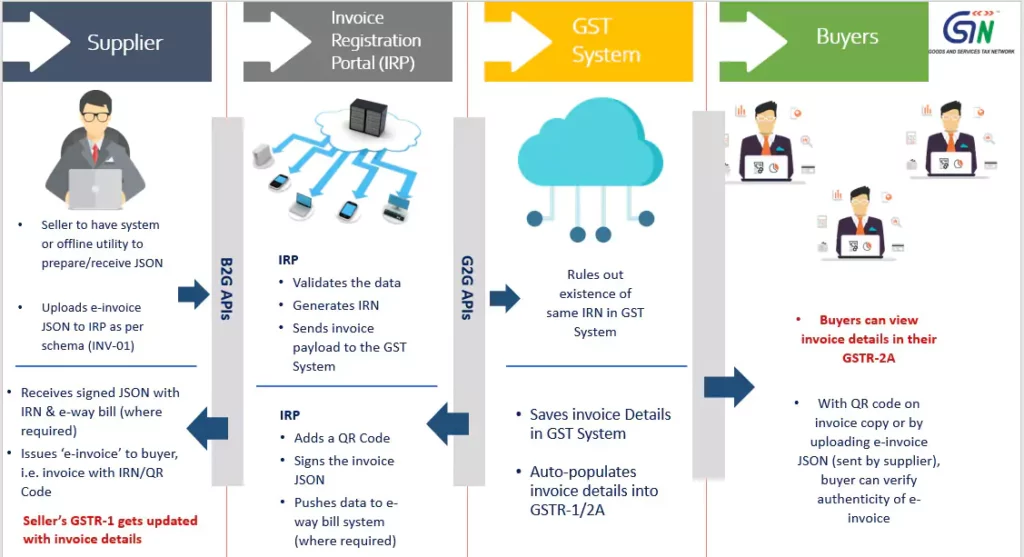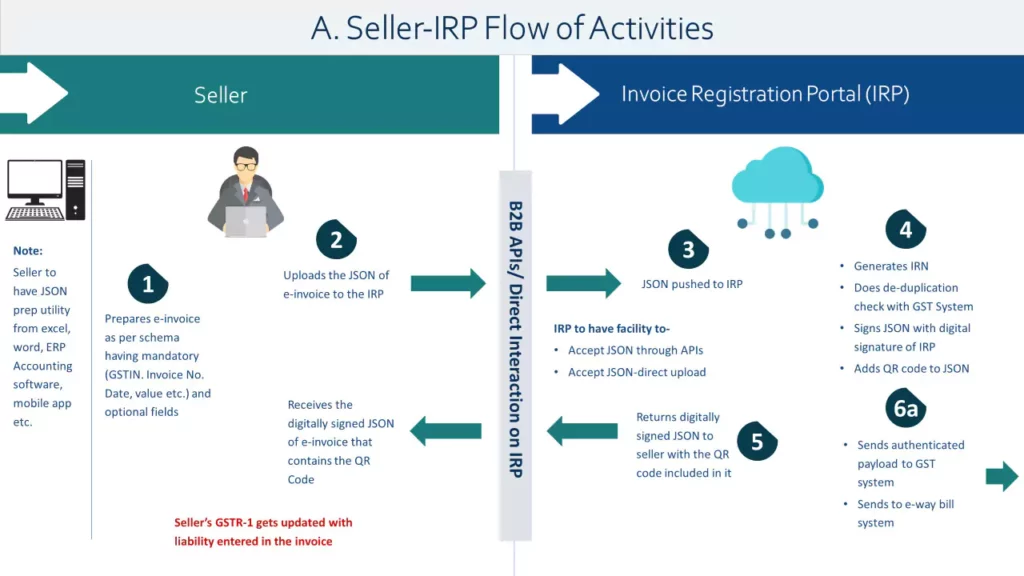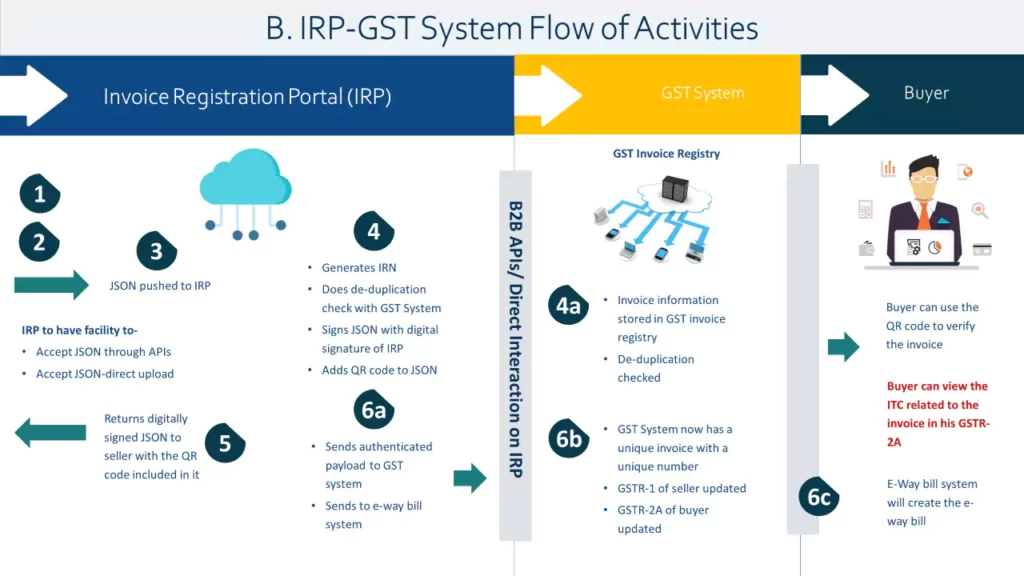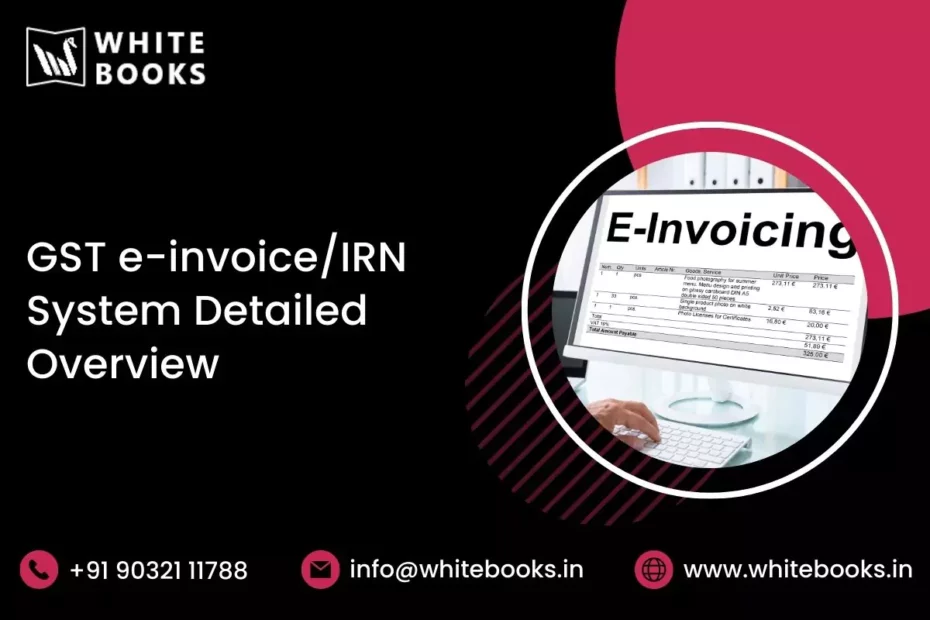Table of Contents
1. e-invoice Background
The GST Council approved the concept of e-invoice in its 37th meeting on September 20, 2019. It was decided to introduce e-invoicing in a phased manner for Business to Business (B2B) and export invoices. However, certain classes of registered persons were exempted from issuing e-invoices based on the recommendations made in the 39th meeting of the GST Council on March 14, 2020. The exempted classes are as follows:
- Special Economic Zone Units: These units operate within designated Special Economic Zones and are exempt from issuing e-invoices.
- Insurer or a banking company or a financial institution, including a non-banking financial company: Entities such as insurers, banks, and financial institutions, including non-banking financial companies, are exempted from issuing e-invoices.
- Goods Transport Agency (GTA) supplying services about transportation of goods by road in a goods carriage: GTA service providers involved in transporting goods by road are exempt from issuing e-invoices.
- Suppliers of passenger transportation service: Suppliers providing passenger transportation services, such as taxi services or bus operators, are exempt from issuing e-invoices.
- Suppliers of services by way of admission to an exhibition of cinematograph films in multiplex screens: Suppliers offering services related to the admission of customers to multiplex screens for the exhibition of cinematograph films are exempt from issuing e-invoices.
These exemptions are specific to the classes of registered persons mentioned above, and they are not required to comply with the e-invoicing requirements.
2. e-invoice – Advantages
E-invoicing provides several benefits for businesses, such as automated reporting of invoices in the GST return and automatically generating e-way bills when necessary. It also promotes standardization and interoperability, reducing disputes among transacting parties and improving payment cycles. Additionally, e-invoicing helps reduce processing costs and significantly enhances overall business efficiency.
The benefits of e-invoice from a GST perspective are enumerated below:
| Area | Outcome |
|---|---|
| Automation of reporting documents for various compliances with GST |
|
| Reduction of tax evasion |
|
| Fraud mitigation | Elimination of fake invoices |
3. e-invoice – Schema (Standard format)
The use of various accounting/billing software by businesses leads to the generation and storage of invoices in different electronic formats. However, these formats are incompatible with the GST System or other software systems suppliers and receivers use. For instance, an invoice generated by the SAP system cannot be read by a machine using the ‘Tally’ system without a connector. Considering that there are more than 300 accounting/billing software products, it is not feasible to have connectors for each.
To address this issue, e-invoicing focuses on machine-readability and uniform interpretation of invoices. The aim is to ensure complete interoperability across the entire GST ecosystem, where invoices generated by one software can be read by any other software, eliminating the need for manual data entry. To achieve this, a standard/format for e-invoice was finalized through extensive consultations with Trade/Industry Bodies such as CII, PHD, FICCI, ASSOCHAM, and the Institute of Chartered Accountants of India (ICAI). Although it is based on international standards like UBL/PEPPOL, the format has been customized to meet India’s specific business practices and requirements.
The finalized schema/format for e-invoice was notified as Form GST INV-1. This standardization ensures consistency and enables seamless data exchange between different software systems, improving efficiency and reducing manual invoice processing and reporting errors.
4. e-invoice – Process
The ‘e-invoice’ system covers various documents, including invoices, credit notes, and debit notes. These documents are issued by specific classes of taxpayers to registered persons or for export purposes. Despite including different types of documents, the system is commonly referred to as ‘e-invoicing’ for simplicity and ease of understanding.
The process of ‘e-invoicing’ does not involve the generation of invoices by a government portal. Taxpayers will continue creating GST invoices using their own accounting/billing/ERP systems. However, these invoices will now be reported to the ‘Invoice Registration Portal (IRP)’. Upon reporting, the IRP will generate a unique ‘Invoice Reference Number (IRN)’, digitally sign the invoice, and return it to the taxpayer. It’s important to note that a GST invoice will only be considered valid with a valid IRN.
In addition to the signed e-invoice, the IRP will generate a QR code, including the unique IRN and other key particulars. This QR code can be printed on the invoice itself, allowing for offline verification of whether the e-invoice has been reported to the IRP using a mobile app or similar tools.
The e-invoice schema specifies the necessary particulars to be reported in electronic format to the IRP to receive the signed e-invoice. Once the invoice is successfully reported to the IRP in JSON format, the supplier will receive a signed JSON file from the IRP, including the QR code data. This payload can be converted into a readable format and populated into a PDF file. If desired, the taxpayer can print the PDF or the invoice, as they currently do, by including their entity logo and any additional information required. The PDF and printed invoice must include the QR code for verification purposes.
5. Cancellation/Amendment of Reported Invoice:
In the e-invoicing system, the seller can cancel the Invoice Reference Number (IRN) for an e-invoice that has already been reported but within a specified time frame. This allows for the cancellation of an e-invoice if necessary.
However, when it comes to amending an e-invoice uploaded to the Invoice Registration Portal (IRP), the amendment process will be handled through the GST portal when filing the GSTR-1 return. Amendments to invoices cannot be made directly through the IRP.
Initially, only one IRP will be available for taxpayers to report their e-invoices. However, additional IRPs will be added over time to ensure availability, redundancy, speed, and a diversified and distributed service. This will provide taxpayers with a choice of IRPs for their e-invoicing needs.
6. e-invoice – Implications for Businesses
Implementing the e-invoicing system will not require significant changes in how businesses currently issue invoices. Businesses will continue to generate invoices in the same manner, whether in physical or electronic (such as PDF) format. The necessary changes to enable the reporting of invoices to the Invoice Registration Portal (IRP) and obtain the Invoice Reference Number (IRN) will be implemented by ERP/Accounting and Billing Software providers in their respective software. Taxpayers can also choose to utilize the services of GST Suvidha Providers (GSPs) services to report their invoice data to the IRP.
To provide flexibility, multiple modes of reporting e-invoices will be available for taxpayers to choose from based on their needs. This includes API-based reporting and GSP-based reporting. Additionally, web-based and mobile app-based reporting options will be made available as the coverage of the e-invoicing system expands by reducing the turnover threshold. This ensures that taxpayers have various options to report their e-invoices to the IRP conveniently.
8. e-invoice – Detailed Work flow
The overall workflow of ‘e-invoice’ system is as follows:

In the e-invoicing system, the seller has the ability to cancel the Invoice Reference Number (IRN) for an e-invoice that has already been reported, but within a specified time frame. This allows for the cancellation of an e-invoice if necessary.
However, when it comes to amending an e-invoice that has been uploaded to the Invoice Registration Portal (IRP), the amendment process will be handled through the GST portal when filing the GSTR-1 return. Amendments to invoices cannot be made directly through the IRP.
Initially, there will be only one IRP available for taxpayers to report their e-invoices. However, in order to ensure availability, redundancy, speed, and a diversified and distributed service, additional IRPs will be added over time. This will provide taxpayers with a choice of IRPs to use for their e-invoicing needs.
The flow of e-invoice generation, reporting/registration, and confirmation receipt can be divided into two main parts:
- Interaction between the business (supplier) and the Invoice Registration Portal (IRP):
- Interaction between the IRP and the GST/E-Way Bill Systems and the Buyer:

8.1. Part A: Flow from Supplier to IRP
Step 1:
involves the seller generating the invoice using their accounting or billing system. The invoice must adhere to the e-invoice schema and include the mandatory parameters. Optional parameters can be included based on the supplier’s business requirements. The seller’s software should be capable of generating a JSON file of the final invoice, which can be uploaded to the Invoice Registration Portal (IRP). Suppose the seller’s software does not support generating JSON files in the required format. In that case, they can request the software provider to enable this feature or seek assistance from service providers specializing in e-invoicing.
Note:
- Sellers should have a utility that can output invoice data in JSON format from their accounting or billing software, ERP system, Excel/Word documents, or even a mobile app. Accounting and billing software companies are encouraged to adopt the e-invoice standard to facilitate the seamless generation and uploading of invoices to the IRP.
- FinTech companies within the ecosystem offer services to fulfil this requirement. If the ERP/accounting/billing software does not provide the necessary functionality, sellers can obtain the service from these providers.
- Small and medium-sized taxpayers without accounting/billing software can utilize free accounting and billing systems offered by GSTN-empaneled providers. Currently, taxpayers with an annual aggregate turnover below Rs 500 crore are not mandated to report e-invoices to the IRP.
Steps 2 and 3
involve the seller uploading and pushing the e-invoice JSON to the IRP. This can be done directly on the IRP platform or through GST Suvidha Providers (GSPs) or third-party software, if available.
Step 4:
The Invoice Registration Portal (IRP) receives the uploaded e-invoice JSON and generates the Invoice Reference Number (IRN). The IRN is computed based on the Supplier’s GSTIN, Document Type, Document Number, and Financial Year. Before assigning the IRN, the IRP cross-checks the details with the Central Registry of the GST System to ensure that the same document from the same supplier for the same financial year is not uploaded again. The IRN, essentially a hash value, serves as a unique identifier for the e-invoice. Upon confirmation from the Central Registry, the IRP adds its signature to the Invoice Data and generates a QR code. The QR code contains relevant information such as the GSTINs of the seller and buyer, invoice number, invoice date, number of line items, HSN (Harmonized System of Nomenclature) code for major commodities, and the hash value. The hash value computed by the IRP becomes the IRN of the e-invoice. The GST System maintains a central registry where hashes from all IRPs are stored to ensure uniqueness.
If the same document has been previously uploaded, the IRP will reject it and notify the supplier with an appropriate error code.
Step 5:
The IRP digitally signs the JSON file containing the e-invoice data and returns it to the seller along with the QR code.
Step 6:
The uploaded e-invoice data, including the IRN, is shared with the GST and e-way bill systems to facilitate further processing and compliance.
8.2. Part B: Flow from IRP to GST System/E-Way Bill System & Buyer:
The following diagram shows how e-Invoice data would be consumed by GST System for the generation of e-way bills or populating relevant parts of GST Returns, stated in Step-6 above.

Step 6(a)
involves sending the signed and authenticated e-invoice data, along with the Invoice Reference Number (IRN) obtained from the Invoice Registration Portal (IRP), to both the GST System and the E-Way Bill System.
Step 6(b)
focuses on the GST System, where the received e-invoice data will be used to update the GSTR-1, the return form for outward supplies.
Step 6(c)
highlights that the e-invoice schema includes parameters like ‘Transporter ID’ and ‘Vehicle Number’, which are required to create and generate e-way bills. The seller can enter these parameters during the generation of the e-invoice, allowing for the seamless creation of the e-way bill using the same data without the need for additional data entry.
Notes :
- Emphasises that the e-invoice schema has mandatory and optional items, and the GST System will only accept e-invoices that include all the mandatory items. The seller and buyer can utilise the optional items based on their specific business needs.
- Mentions that there is currently only one registrar (IRP), but another registrar will soon be added to provide redundancy. Sellers have the option to send their e-invoice for registration to multiple registrars. Still, the IRP will perform a de-duplication check with the central registry maintained at the GST System to ensure a unique IRN is generated for each invoice. Only one IRP will return a valid IRN, while the others will reject the registration request.
- Highlights that the QR code included in the e-invoice allows for quick viewing, validation, and access to the invoices from the GST system using handheld devices.
9. e-invoice – Salient Features
9.1. Unique Invoice Reference Number (IRN):
Generating a unique IRN is crucial to avoid duplication and ensure the uniqueness of each invoice. The IRN is computed by applying a hash function to specific parameters, including the GSTIN (Goods and Services Tax Identification Number) of the document generator (supplier), the Financial Year, the Document Type, and the Document number (e.g., invoice number).
This computation is standardized and published in the e-invoice standard. Regardless of the registrar processing the invoice, the resulting hash will always be the same for this combination of parameters.
To ensure de-duplication, the registrar sends the computed hash to the Central Registry of the GST System. The Central Registry maintains records of previously reported invoices. Suppose the hash matches an existing IRN in the Central Registry, indicating that the invoice has already been reported. In that case, the registrar will reject the registration and notify the sender with an appropriate error code. This process guarantees that the registrar accepts and registers unique invoices from a taxpayer.
9.2. Digital Signing of e-Invoice by Invoice Registration Portal (IRP)
Once the invoice data is uploaded to the Invoice Registration Portal (IRP), the IRP performs several actions to ensure the authenticity and integrity of the e-invoice. One crucial step is the digital signing of the e-invoice.
Upon receiving the invoice date, the IRP generates the hash (IRN) using the specified parameters, as mentioned earlier. This hash serves as a unique identifier for the e-invoice. Subsequently, the IRP applies digital signatures to the entire e-invoice JSON payload, including the IRN/hash.
Digital signing involves using the IRP’s private key, which the IRP securely holds. By digitally signing the e-invoice, the IRP confirms that the portal has verified and authenticated the invoice data. The digitally signed e-invoice becomes a valid document for the seller and can be used for business transactions.
The digital signature adds a layer of trust and security to the e-invoice, as any tampering or modification to the signed JSON will invalidate the signature, ensuring the document’s integrity.
9.3. QR Code with key particulars
In addition to the digital signature, the IRP generates a QR code containing important e-invoice information. The QR code serves as a quick and convenient way to verify the authenticity of the invoice, especially in situations where internet connectivity may be limited, such as during road checks by tax officers.
The QR code includes the following key particulars of the e-invoice:
- GSTIN of the Supplier
- GSTIN of the Recipient
- Invoice number assigned by the Supplier
- Date of invoice generation
- Invoice value, including the taxable value and gross tax amount
- Number of line items in the invoice
- HSN code of the main item, which refers to the line item with the highest taxable value
- Unique IRN (Invoice Reference Number/hash)
- Date of generation of the IRN
The QR code serves as a tamper-proof representation of the e-invoice and contains both the IRN and the digital signature of the IRP. By scanning the QR code using a mobile app provided, taxpayers and tax officers can easily authenticate the e-invoice and verify its essential details.
Alternatively, the authenticity and correctness of the e-invoice can also be verified by uploading the signed JSON file or the signed QR code (in string format) on the e-invoice portal.
It is important to note that the IRP does not store the invoices. The primary function of the IRP is to provide invoice registration and verification services, generate the IRN and QR codes, and ensure the efficiency and speed of the process.
9.4. Multiple Registrars/IRPs
To ensure uninterrupted operations, multiple registrars (IRPs) will be established. The first registrar will be NIC, and additional registrars (IRPs) will be introduced over time. This multi-registrar system ensures round-the-clock availability and efficiency in the e-invoice process.
9.5. Standardization of e-Invoice
The standardization of e-invoices has been achieved through the efforts of a technical group formed by the GST Council Secretariat. This group conducted consultations with industry stakeholders to draft the e-invoice standards. The finalized e-invoice schema/template has been notified as Form GST-INV-1.
9.6. Multiple Modes for reporting e-invoice
Various modes are available for taxpayers to report e-invoices, offering flexibility to choose the most suitable option based on their needs. These modes include:
- API-based integration with the taxpayer’s system directly: Taxpayers can directly integrate their existing systems with the e-invoice system using APIs (Application Programming Interfaces) provided by the IRP (Invoice Registration Portal).
- API-based integration with the taxpayer’s system through GSP/ASP: Taxpayers can integrate their systems with the e-invoice system through GSPs (GST Suvidha Providers) or ASPs (Application Service Providers), who offer API-based integration services.
- Free Offline Utility (Bulk Generation Tool): The IRP provides a free offline utility tool called the ‘Bulk Generation Tool.’ Taxpayers can download this tool from the IRP to generate e-invoices in bulk offline. Once generated, these e-invoices can be uploaded to the IRP for registration.
Additional modes, such as web-based and mobile app-based, may also be introduced to facilitate further e-invoice reporting.
9.7. Printing of e-Invoice:
Once the supplier receives the signed JSON from the IRP (Invoice Registration Portal), it can be converted into a readable format and populated into a PDF file. If the taxpayer wishes, they can print the e-invoice as a paper invoice, similar to their current practice. They can also include their entity logo and other necessary information on the printed invoice.
It’s important to note that the e-invoice schema only mandates what information needs to be reported in electronic format to the IRP and to receive the corresponding signed e-invoices from the IRP. However, when printing the e-invoice, it is necessary to include the QR code as one of the mandatory particulars according to Rule 46 of the CGST (Central Goods and Services Tax) Rules. The QR code contains essential details of the e-invoice and facilitates easy verification and authentication.
9.8. Cancellation of e-invoice:
The seller can initiate the cancellation of the Invoice Reference Number (IRN) for an e-invoice that has already been reported if there is a need to cancel that invoice. The cancellation process should adhere to the procedures outlined in the accounting standards and other relevant rules and regulations. The cancellation of an e-invoice is permitted within a specified period after the generation of the IRN.
To cancel an e-invoice, the seller can utilize the ‘Cancel IRN’ API, available on the e-invoice sandbox portal. This API is a POST API, requiring the invoice’s IRN to be cancelled as the key parameter in the payload. For more detailed information on the specifications and the exchange and handling of the payload and responses, it is recommended to refer to the e-invoice sandbox portal.
It’s important to note that once an invoice is cancelled, the invoice number used for that cancelled invoice cannot be reused.
10. Amendment of e-invoice already reported
Amendments to e-invoices that have already been uploaded on the Invoice Registration Portal (IRP) can be made through the GST portal when filing the GSTR-1 return. Amending e-invoices involves making the necessary changes or updating the invoice details on the GST portal while filing the GSTR-1 return. The amended information will be reflected in the GSTR-1 return, which reports outward supplies.
It’s important to note that amendments to e-invoices should be made within the applicable timelines and by the rules and regulations set forth by the GST authorities.
